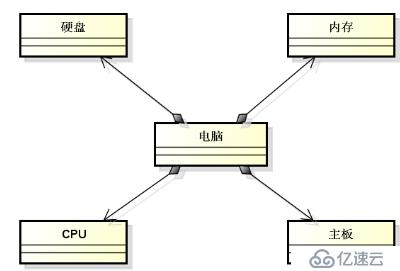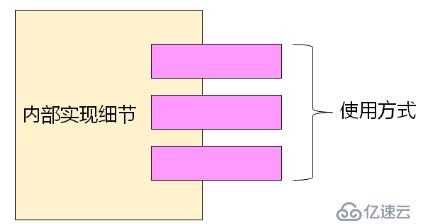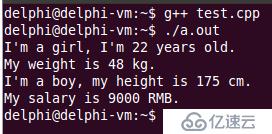一.类的组合
电脑一般而言是由CPU、内存、主板、键盘和硬盘等部件组合而成。下图可以表示该关系
A.类通常分为以下两个部分
1.类的实现细节
2.类的使用方式
1.当使用类时,不需要关心其实现细节
2.当创建类时,才需要考虑其内部实现细节
二.封装的基本概念
C++中类的封装
1.成员变量:C++中用于表示类属性的变量
2.成员函数:C++中用于表示类行为的函数
3.C++中可以给成员变量和成员函数定义访问级别--public:成员变量和成员函数可以在类的内部和外界访问和调用;private:成员变量和成员 函数只能在类的内部被访问和调用
代码示例
#include <stdio.h>
struct Biology {
bool living;
};
struct Animal : Biology {
bool movable;
void findFood() { }
};
struct Plant : Biology {
bool growable;
};
struct Beast : Animal {
void sleep() { }
};
struct Human : Animal {
void sleep() { }
void work() { }
};
struct Gril:human
{
private:
int age;
int weight;
public:
void print()
{
age = 22;
weight = 48;
printf("I'm a girl, I'm %d years old.\n", age);
printf("My weight is %d kg.\n", weight);
}
};
struct Boy:human
{
private:
int height;
int salary;
public:
int age;
int weight;
void print()
{
height = 175;
salary = 9000;
printf("I'm a boy, my height is %d cm.\n", height);
printf("My salary is %d RMB.\n", salary);
}
};
int main()
{
Gril g;
Boy b;
return 0;
}输出结果
三.类成员的作用域
1.类成员的作用域都只在类的内部,外部无法直接访问
2.成员函数可以直接访问成员变量和调用成员函数
3.类的外部可以通过变量访问publi成员
4.类成员的作用域与访问级别没有关系
C++中用struct定义的类中所有成员默认为public
代码实现
#include <stdio.h>
int i = 1;
struct Test
{
private:
int i;
public:
int j;
int getI()
{
i = 3;
return i;
}
};
int main()
{
int i = 2;
Test test;
test.j = 4;
printf("i = %d\n", i); // i = 2;局部变量
printf("::i = %d\n", ::i); // ::i = 1;全部变量
// printf("test.i = %d\n", test.i); // Error
printf("test.j = %d\n", test.j); // test.j = 4
printf("test.getI() = %d\n", test.getI()); // test.getI() = 3
return 0;
}小结
1.类通常可以分为使用方式和内部细节两部分
2.类的封装机制使得使用方式和内部细节相分离
3.C++中通过定义类成员的访问级别实现封装机制
4.public成员可以在类的内部和外界访问和调用
5.private成员只能在类的内部被访问和调用
在C++中提供新的关键字class用于类定义
在用struct定义类时,所有成员的默认访问级别为public
在用class定义类时,所有成员的默认访问级别为private
亿速云「云服务器」,即开即用、新一代英特尔至强铂金CPU、三副本存储NVMe SSD云盘,价格低至29元/月。点击查看>>
免责声明:本站发布的内容(图片、视频和文字)以原创、转载和分享为主,文章观点不代表本网站立场,如果涉及侵权请联系站长邮箱:is@yisu.com进行举报,并提供相关证据,一经查实,将立刻删除涉嫌侵权内容。